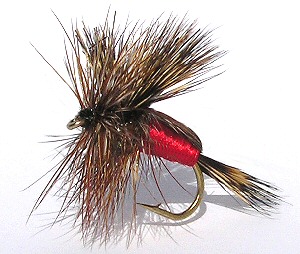Red Humpy Dry Fly
The North American Humpy fly pattern is mainly a fast water attractor with very good floatability and visibility. The origin of the Humpy pattern is in dispute. Some say it is a combination of Jack Horner’s Deer Hair pattern and Canada’s Tom Thumb. Both patterns were in use on Western North American streams in the late 1930’s.

HUMPY DRY FLY PATTERNS. Hook size 12 14 16 - $US each
Fast water trout fishing with a Humpy dry fly
I like to use a Red Humpy Dry Fly as my top fly on a team of three when fishing a river in spate after a thunderstorm or when fishing rough water. Fast rain fed rivers can be a little daunting to the trout fly fisherman more used to fishing stillwaters. This is due mainly to lack of familiarity rather than lack of angling skill. Such fast flowing rivers often have rocky beds as the build-up of natural silt from rotting vegetation does not occur due to it being washed away regularly down-stream.
Plants attach themselves to the large rocks and this makes them slippery. Since many of these rivers are best fished by wading, the first essentials are safe waders and a stout weighted
wading staff
. The safest waders
are those with felt soles, though beware, such soles are also slippery on grass between pools. Studded boots are not so secure and are also noisy on the rocks. The best staff has a thumb crotch and a lanyard. It not only acts as a third leg but also sounds the depth.
Leaders can be 10 ft long with two droppers attached. For trout and grayling mine taper down to a 3lb breaking strain point. The distance between the droppers is a personal choice. I find that the wider apart the gap the less prone they are to tangles. Contrary to some opinions, the droppers are better on longish lengths of nylon, say 12 to 18 inches.
My fast water team would have a biggish point fly on the bottom dropper like a beaded Gold Ribbed Hares Ear size 12 or 14. The middle dropper would be a hook sized 16 soft hackle wet fly. On top I would select a foam enhanced fly like a suspender buzzer or a buoyant Wulff, Red Humpy dry fly, Goddard Caddis or Adam’s Irresistible dry fly. A wetting agent for leader and flies is important to get them to their working depth quickly.
A still water angler will have no problem with his casting. Suffice it to say that the choice of up or down steam casting is best left to the wind. Straightforward downsteam fishing is easiest because the current manages the line. It is usually to throw a long line downsteam as nearby fish will be spooked as you work down towards them.
Upstream fishing is with a shorter line which is harder to manage since the current brings it back to the caster as soon as it falls. Sinking lines cannot be mended or easily rolled as a floating or neutral density line.
Line management is essential. Especially to prevent your flies skating when swinging across the river below you. Line mending is the answer, or by releasing some slack line. The timing of these manoeuvers soon becomes obvious. The opposite is also true to keep the flies alive in slacks and eddies, handline retrieves, or rod tip lift.
Upstream as the line tumbles back, the rod is raised progressively and the line retrieved with the free hand. It is sensible to work the top dropper on the surface as in drift-fishing in a boat. The short line upstream is at first strange as you may take fish within a rod length or so, providing you wade with care. It makes sense to fish lies where the force of the current is diverted away, say in front of, or behind boulders.
LINKEDIN READER'S COMMENT
You can trim the lower hackles to make the Humpy lay lower on the surface also. You can twitch them to trigger a strike without sinking them too. If you are catching a lot of fish or bouncing them off rocks, etc. the Humpies can get a little chewed up. Carry a few extras. - By Don Brier


Fly Fishing books

